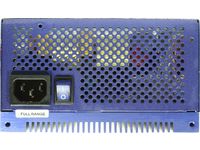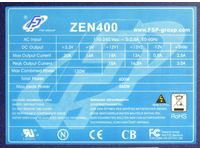Silent PSUs: Fortron Versus Silverstone
Fortron/FSP Zen 400 (Continued)
On the rear of the power supply you’ll find the IEC socket and a blue illuminated main switch. The latter is of particular importance, as a user operating a passive power supply cannot hear whether or not it is switched on. There are no other indicators showing the operational status of the unit.
The power supply is a full range unit that can be operated on a voltage ranging between 110 V and 240 V. There is no need to manually switch between the voltage ranges.
The output of the power supply is 400 watts, and 560 watt peaks are possible for short periods of time. The combined performance of the 3.3 V and 5 V rails is a maximum of 130 watts.
During use, the power supply makes its presence known by a high-pitched, high-frequency noise that occurs most often when under heavy use. Up to a load of approximately 250 watts this noise can hardly be heard, but the higher the load gets, the louder the noise. This is a very annoying noise that detracts from the "silent PC" concept.
With no additional ventilation, constant operation under full load at 400 watts is not possible. The power supply switches itself off due to overheating after approximately two hours. A level of 300 watts, however, can be maintained permanently. A minimal movement of air in the computer case—such as a slowly rotating 120 mm fan—enables the device to be operated permanently at high load.
The test with the D201GLY2 board from Intel was not a problem—this kind of mini ITX board often causes problems with power supplies.
Get Tom's Hardware's best news and in-depth reviews, straight to your inbox.
-
knowom I think they'd be great for a digital audio workstation environment now if only there was some more competition in this market segment to drive prices down to a more decent level.Reply -
mdmadph "The +12V CPU connection is only available as 4-pin version, which can lead to problems with some boards that require an 8-pin connection."Reply
Know of many HTPC boards that need an 8-pin CPU connection? :\ I sure don't. -
I have read 3-4 other reviews of the zen 400W, and I'm pretty sure there has been no mention of the high pitched sound. It's not a good sign for the zen, but it's probably a faulty powersupply tested in this review.Reply
-
gwolfman Ummmm, so where's the temps? The review is practically pointless without temp measurements on a fanless PSU. BOOOOO!Reply -
jeffunit Without specifying the input voltage, efficiency measurements are pretty useless. Running at 240v will yield a few percent higher efficiency than 120. Even 240v will be more efficient than 220v.Reply -
kittle Re-run your review and include tempratures. Its pointless w/o them.Reply
If you have found a fanless PSU thats safe to touch -- thats great. but if these things get to 40, 50, 60c - then we need to know not to buy them. -
I own the Zen400 power supply and it's exactly what I needed for a quiet HTPC, to the point where it's literally impossible to tell when the PC is on. During normal operation I have never heard the high pitched sound this review mentions (although it did output a sound similar in volume and annoyance to a smoke alarm when I failed to plug in the power cable to the graphics card - it was clearly an error/failure tone).Reply
-
In regards to the lack of the 8 pin CPU 12v connector, if you can find a motherboard of which the 4 +12v pins of the port are not electrically connected, please point it out to actually justify needing the 8 pin connector. To be honest, a motherboard with a single +12v pin isolated to only 1 or 2 vcore phases would'nt be any motherboard you would want to purchase, for power efficiency reasons.Reply
-
Alternator I agree with the above posters, temps would be nice, and not just of the PSU...Reply
I am quite interested in getting a capable (above 400watt) PSU that doesn't require a fan, but I really need to keep an eye on the temperatures.
I have a fanless mb and vid card (3850 radeon), and would wonder if adding a fanless psu into the mix would jeopardise the system by reducing the air flow through the case. (after all I wouldn't get a fanless PSU if my other components were noisy to begin with!?)
Perhaps an article focused more on configuring a quiet computer (for the purpose of gaming) could be in order?


